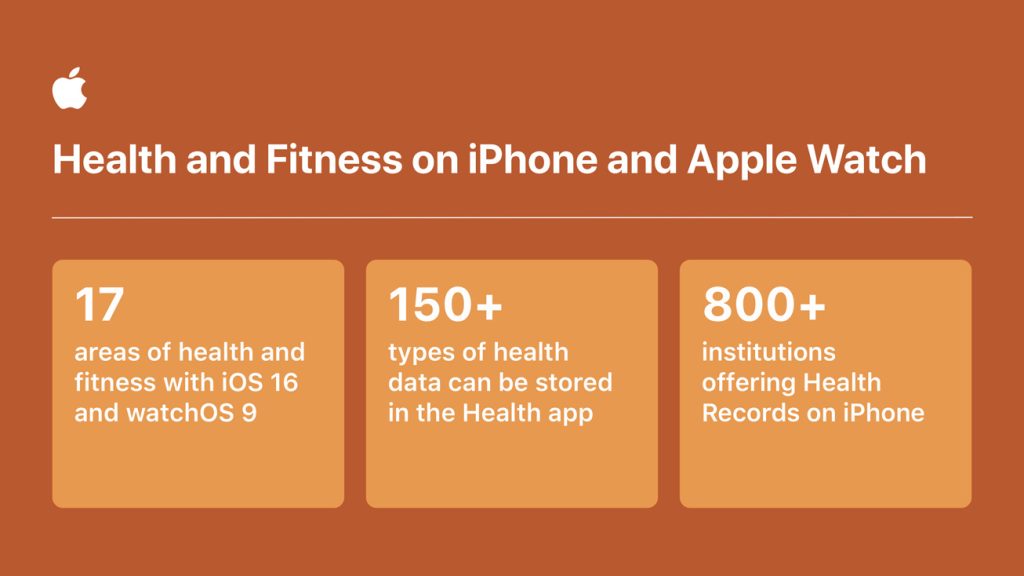A new report shares the ways Apple products are helping users, developers, and health organisations advance personal health, research, and care
Today Apple shared a new report that offers a snapshot of the ways Apple products are empowering people to be at the centre of their health, and acting as an intelligent guardian for their health and safety. Users, developers, medical institutions, and health organisations around the world are using Apple devices, features, and APIs to break down barriers between people and their health information, all while keeping privacy in mind.
Apple’s efforts to advance health primarily fall into two categories, which are detailed in two corresponding sections of the report. The first section describes Apple’s focus on personal health and fitness features on Apple Watch and iPhone that offer actionable, science-based insights and help protect users’ health and safety. The second section shares Apple’s work with the medical community to support research and care. Both sections — along with an Extensions and Spotlights section at the report’s end — include a variety of examples of third-party developers, health institutions, and organisations innovating with Apple technology.
We believe passionately that technology can play a role in improving health outcomes and encouraging people to live a healthier day, and we are excited about the many ways users are benefiting from our health and fitness features, and by the ways third-party developers, institutions, and organisations are using Apple technology to advance health and science,” said Jeff Williams, Apple’s chief operating officer. “Our vision for the future is to continue to create science-based technology that equips people with even more information and acts as an intelligent guardian for their health, so they’re no longer passengers on their own health journey. Instead, we want people to be firmly in the driver’s seat with meaningful, actionable insights.
Empowering Users on Their Personal Health Journeys
Since the release of the Health app in 2014 and Apple Watch in 2015, Apple has introduced a wide array of innovative health and fitness features, with the goal to provide users with easy-to-understand, meaningful insights so they can be empowered to live a healthier life. The report outlines the four pillars of Apple’s health and fitness features: 1) giving users a central and secure place to store and view their health data in the Health app, 2) offering features that enable Apple Watch to act as an intelligent guardian for users’ health, 3) offering features that help users improve their everyday health and fitness for better health outcomes, and 4) fuelling innovative third-party health and fitness apps with developer tools.
With the release of iOS 16 and watchOS 9 this fall, Apple Watch and iPhone will offer features that focus on 17 areas of health and fitness, from heart health and sleep to mobility and women’s health, and more. Over the years, customers of all ages have shared how these health and fitness features have, in their own words, changed their lives. Several share their stories in the report, including customers who have discovered serious heart conditions, received emergency assistance after a fall, or dramatically improved their health through daily activity.

Users can now store over 150 different types of health data from Apple Watch, iPhone, and connected third-party apps and devices in one central view in the Health app, in addition to available health records data from connected institutions in the US, UK, and Canada. There are now tens of thousands of apps on the App Store that use the HealthKit API, which allows developers to incorporate data users choose to share from the Health app to offer innovative health and fitness experiences, with rigorous privacy and data security protocols. The report spotlights examples of globally popular HealthKit-enabled apps like Nike Run Club, Calm, and WeightWatchers, plus an increasing number of HealthKit-enabled apps — including Qardio heart health and Withings Health Mate — that use connected accessories to allow users to track and monitor even more aspects of their health.
Supporting the Health Ecosystem by Collaborating with the Medical Community
Apple believes the strongest health innovations are possible only through direct collaboration with the medical community, and the report describes four categories of this collaboration: 1) building tools to enable researchers to make new scientific discoveries, 2) helping strengthen the physician-patient relationship with meaningful data, 3) collaborating with health organizations to promote healthy lifestyles at large scale, and 4) supporting public health and government initiatives.
The ResearchKit framework gives researchers the opportunity to recruit study participants from a large user base of iPhone and Apple Watch users, and for participants to choose to share health data to help advance science. Through the Research app, Apple has collaborated with Harvard T.H. Chan School of Public Health and the National Institute of Environmental Health Sciences, Brigham and Women’s Hospital and the American Heart Association, and the University of Michigan and World Health Organization to offer users across the US the opportunity to participate in three first-of-their-kind research studies: the Apple Women’s Health Study, the Apple Heart and Movement Study, and the Apple Hearing Study. Early learnings from the studies appear in the report, as well as information on other studies Apple has supported, like the Heart Failure Study with University Health Network and the Digital Mental Health Study with UCLA.
Health Records on iPhone in the Health app, along with apps and devices developed by third parties using Apple developer tools, help strengthen physician-patient relationships with meaningful data. Health Records is now available to patients at over 800 institutions across over 12,000 locations, making it easy for patients to see their available medical data from multiple providers in the Health app whenever they choose. Research has shown that connecting patients with their care teams remotely results in better outcomes with the Corrie Health app, UVA Health care at home programs, and the US Department of Veterans Affairs loaning Apple devices to veterans to connect them with their VA healthcare services. Care teams are better able to help patients with chronic conditions at Ochsner Health System and NHS Sunderland, and remote monitoring is reducing the cost and length of stays in the neonatal intensive care units at Odense University Hospital and the University of Virginia Children’s Hospital, where premature babies can come home with their parents but stay connected to care teams remotely.
Health organisations and companies around the world — including Paceline in the US; Vitality Active Rewards in the US, the UK, South Africa, and Australia; and LumiHealth in Singapore — have collaborated with Apple to integrate Apple Watch into their wellness programs. There are currently 55 programs running in 17 countries with over a million users taking part in an incentive program leveraging Apple Watch. These programs have been successful in increasing participants’ physical activity levels and uptake of health behaviors, such as aiming for more regular sleep patterns, focusing on mindfulness, and swapping in healthier food options.
Finally, the report highlights Apple’s partnerships with clinicians and local governments on unique ways to support their crucial work to promote public health, including building apps and features during the COVID-19 health crisis.
Grounded in Science and Designed Around Privacy
All of Apple’s health and fitness features have been developed with two overarching principles:
- Rigorous scientific validation processes: Apple’s in-house clinicians are deeply involved in the product development process, and work hand-in-hand with engineers and product designers. This, combined with collaboration with experts from leading research institutions, ensures that products and features are grounded in science and user-friendly.
- Privacy at the centre: Privacy is a core value at Apple, and data privacy is critical for sensitive health data. Apple’s health and fitness features put users’ privacy at the center, and provide users with protections, including transparency and control. When iPhone is locked with a passcode, Touch ID, or Face ID, all health and fitness data in the Health app — other than Medical ID — is encrypted, and any health data synced to iCloud is encrypted both in transit and on Apple servers. And if a user has a recent version of watchOS and iOS with the default two-factor authentication and a passcode, their health and activity data will be stored in a way that Apple can’t read it. Health app data is never shared with any third party without the user’s explicit permission, and if users decide to share their health data, the Health app provides users with granular control over the types of data they share and who they share it with. They can review and manage permissions at any time.
Press Contacts
Eva Borri
Apple
(65) 9770 1057
Izzie Saleh Ali
Apple
(65) 8876 5933



